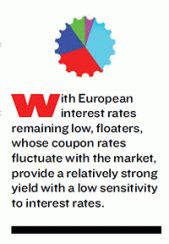To view a PDF of the report, click here.
Assets allocated to passive investment products continue to grow, having hit a global record of $4 trillion. Continued innovations in fixed income, factor-based products, and ESG keep the new product pipeline full.
The inflows keep coming—39 straight months. At the end of April, assets invested in ETFs and ETPs listed globally surpassed $4 trillion, a new record, according to London-based consultancy ETFGI. Year to date, a record $235.21 billion in net new assets have been gathered, far surpassing the $81.01 billion during same period in 2016.
“Investors have come back to equities this year,” says Matthieu Guignard, head of product development and capital markets at Amundi ETF, Indexing and Smart Beta. Fixed income was among the themes for 2016, particularly in Europe, in terms of net new assets, and this year has seen significant flows into equity ETF products. “It’s pretty well split among regions and categories,” he says, with European, North American, and Japanese equity products seeing inflows along with smart beta products and key industry sectors. Year-to-date inflows in the European market reflect those globally, with nearly EUR 35 billion of net new assets, compared with EUR 40 billion for all of 2016. “In April alone, Amundi was the leading provider in Europe for net new assets, capturing 40 percent of flows in European ETFs, so it’s a very positive year already,” Guignard says.
“The entire passive industry and ETFs in particular have grown substantially,” says Clemens Reuter, global head of passive and ETF investment specialists at UBS Asset Management. “It’s an evolution of the financial markets,” he says. The demand for ETF solutions runs horizontally through asset classes, as well as vertically—for example, equities tilted toward smart beta or socially responsible investing. In addition, product features like currency-hedging, duration-hedging, and embedded options are in demand. “This is a more sophisticated appetite for ETFs across the board and the best evidence of their increasing adoption in more complex asset allocation programs and different investment objectives,” he says.
“The move to passive instruments is driven by various motivations—some obvious and some more nuanced,” says Arne Noack, head of ETP development at Deutsche Asset Management. The more obvious include underperformance by active managers and lower fees. Furthermore, Noack notices an increasing level of awareness among investors of the importance that overall asset allocation is taking over stock selection. “Stock selection is becoming less important as investors focus more on portfolio diversification, and how well they are spread across different asset classes,” he says.
Smart Beta
Indeed, many investors are turning to defined asset allocation models based on risk factors. “This is a pretty new concept,” says Guignard. “We’re quite familiar with core-satellite and sector rotation, and now we are starting to see factor rotation.” The idea is that all factors do not behave the same in different market conditions or in different economic cycles. For example, when markets are expanding, momentum or quality tend to outperform, while low volatility tends to underperform. In a contracting market, the opposite tends to hold true. “It’s interesting to look at quantitative indicators like growth, inflation, interest rates and identify the allocation signals,” he says. “We’re already witnessing this among some of our investors who are implementing factor allocations in their portfolios.”

The shift to factor-based investing, which includes smart beta, is a significant element of the growth of passive investing. While inflows into factor-based products remain relatively small compared to those of their market-cap counterparts, smart beta is largely driving new ETF product development. The conversation around factor investing puts a spotlight onto active managers’ claims of alpha generation, which, for the most part, turns out to be a function of the risk factors—such as size, volatility, value, momentum—that an active manager inherently uses in his or her investment style. For example, a fund manager that specializes in small-cap stocks might generate stronger returns than a broad benchmark index by allocating to smaller stocks. The outperformance claim could be the manager’s investment process and skill, but it also could be a systematic exposure to the size factor.
“Historically, in the active world, the two could be indistinguishable,” says Noack, but the introduction of factor-based indices allows investors to differentiate which is which. Now, comparing the manager’s outperformance to a small-cap index could betray skill in favor of taking a systematic factor exposure. “It’s less opaque, which gives more power to the investor,” he says. Investors can begin to focus on those factors that drive returns or reduce risk and work more closely with those active managers that do, in fact, deliver excess returns beyond style factors.
Other Drivers
While equity inflows have been the hallmark of 2017, fixed income still remains active. “Investors are seeking yield in fixed income, but they fear interest rates will rise, and we’ve seen strong inflows to floaters,” says Guignard. “The floater ETF that Amundi issued two years ago now is the leading fixed-income ETF in terms of net new assets in Europe this year.” With European interest rates remaining low, floaters, whose coupon rates fluctuate with the market, provide a relatively strong yield with a low sensitivity to interest rates. “Price volatility is low and you have a very low duration risk,” Guignard says.
Amundi has introduced a range of new fixed income products as well, including a global aggregate credit ETF, which is a difficult index to replicate. “The individual bonds can be very difficult for investors to access, so this is where the ETF wrapper does what it’s supposed to do—provide easy, transparent, liquid, low-cost access,” says Guignard. Others include two higher-yielding strategies for investment-grade corporate bonds. These focus on triple-B rated credit with low duration one-to-five year maturities. “One version focuses on the U.S., the other, Europe,” he says.
Socially responsible investing and its offshoot, ESG, an investment thesis based on environmental, social, and governance factors, is another area of interest in the ETF universe. “We’ve seen extraordinary growth among investors, which continues at a steady pace,” says Reuter, who cites a growing number of investor requests for solutions that address concerns like low carbon, gender diversity, and business ethics.
“Investors are requesting specific solutions and targeted exposures,” says Reuter. These include issuer-capped emerging market debt, short-term TIPS or interest rate-hedged U.S. corporates. “Fixed income ETFs are likely to see accelerating growth and there is much work to be done here, relative to equity ETFs, on both the index and product levels,” he says. The commodity space is also seeing interest perking up after its post-financial crisis slump. “All in all, there are tremendous developments in the ETF world, and there will certainly be more innovative solutions over the next few years.” —Howard Moore





